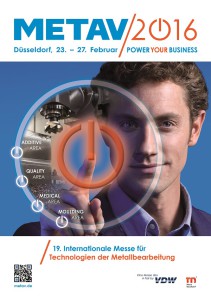 Experts from the academic community and the industrial sector will be showcasing the current state of the art at the METAV in Düsseldorf from 23 to 27 February 2016.
Experts from the academic community and the industrial sector will be showcasing the current state of the art at the METAV in Düsseldorf from 23 to 27 February 2016.
The metrological units involved include bar, Hz, µm, kW, m/min, kN, rad or rpm. That’s just a small excerpt from the list of measured variables that describe the ongoing process status of a production operation. Only when these data are continuously available in real-time can a stable production process be implemented. The focus here is on achieving full coverage with the as-yet-incomplete control circuits. One important technical tool for this purpose is inline metrology, integrated into the production process. “Production metrology provides the foundations for imaging the real factory world,” explains Walter Kimmelmann, who heads the Model-Based Systems Department at the Faculty for Production Metrology and Quality Management of the Machine Tool Laboratory at RWTH in Aachen University. “With the data thus acquired and evaluated, the ideal operating points can be determined and optimised in a model world, and then serve as manipulated variables for controlling the real production world,” to quote the expert.
For this job profile, very sturdy and durable sensor technology is needed, which can always be relied upon to function dependably round the clock in a machine tool even under what are sometimes very harsh environmental conditions. “The golden rule of metrology applies here,” emphasises Walter Kimmelmann. “It has to be better than the anticipated tolerance by a factor of 10.” After all, the production staff can only intervene sensibly in the process if they’re getting soundly based, dependable measured data.
In recent years, laser-based measuring systems have proved their worth in Aachen, since they exert only a slight influence on the manufacturing process. Other processes, such as inclination scales, are also options, but have to be permanently installed in the machine. “We opt almost entirely for light-based technologies, rooted in modern-day coordinate measuring equipment,” says Martin Peterek. “Optics are going to increasingly displace tactile processes, since you obtain significantly more information in a shorter time.” The possibilities opened up by optical metrology in interaction with the industrial sector are demonstrated by a robot cell for assembling truck drivers’ cabs. To quote Walter Kimmelmann: “An external, mobile coordinate measuring system on an optical basis acquires the location of the truck cab on an assembly line, and the entire surroundings in six degrees of freedom, so that the robot “knows” how and where, for example, it fits a windscreen to an accuracy of 100 to 200 µm.”
METAV 2016 has a quality area. The Group Leader interprets it as a significant upgrading in the perceived importance of his specialism, since “we basically have the appropriate metrological equipment for machine tools, robotics, and a vast majority of automation solutions”. Prof. Dr.-Ing. Robert Schmitt, who heads the Faculty of Production Metrology and Quality Management, and is Director of the German Society for Quality (DGQ) sees the Quality Area not least as an opportunity “to break down the functional-organisational walls between the production and metrological specialisms”.


